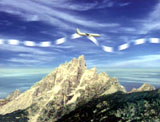Mountain Wave
As your flight approaches mountainous terrain, you start feeling increasing turbulence and then a series of small descents and climbs. The Captain turns on the seat belt sign and says "Folks, Air Traffic Control tells us we can expect some mountain wave in the area and at all altitudes for the next 50 miles. Please stay seated and I've asked the flight attendants to be seated for their safety and yours. Thank you."
What is mountain wave and what does it mean? Strong winds blowing across mountains can produce invisible and rolling waves of air. Imagine a tsunami wave breaking on the beach and you can see the effect of this wave. Strong up and down drafts are associated with mountain wave and will occur on the leeward side of the mountain range. Another sign of is the appearance of lenticular clouds. These clouds are half-almond shaped in appearance. A smooth appearance indicates smooth air, a ragged appearance indicates rough air. Reports of strong surface gusts or blowing dust on the lee side of mountains, especially during dry conditions is another sign of possible wave activity.
Mountain wave activity in many parts of the world is very much dependent on the season of the year. In the United States, conditions are most favorable during winter. This is because the jet stream is stronger and can have a stronger windshear component. This is especially true of the Front Range of the Rocky Mountains in the western United States.

Mountain Wave
Mountain Wave back to My Airline Flight